About the Spatial Sound Institute:
In Conversation with Paul Oomen (2016)
In October 2015 we opened the doors to our new home, the Spatial Sound Institute in Budapest, Hungary. In this interview, founder Paul Oomen discusses the role of the Institute in the longer term scope of 4DSOUND, the intense construction phase of the space and impressions of our opening night as part of Contemporary Arts Festival Budapest.
Where did the idea for the Spatial Sound Institute come from?
During the last months of 2014, John Connell, the team and I worked out our creative direction for 4DSOUND that would guide our thinking and decisions for the next years. We concluded that spatial sound is a new medium, with its own rules and values as yet to be defined and discovered. We proposed a hypothesis to explore: that spatial awareness and how we understand space through sound plays an integral role in the development of our cognitive capacities. As a result, there will be new ways to discover how we can express ourselves through space, and our understanding of the nature of space itself will evolve.
Central in our plan for the project was to establish a laboratory for artists, thinkers and scientists to explore ideas about space through sound, and create a platform for cross-fertilization of different fields of knowledge to further the development of the medium. The lab would also function as a new platform for spatial listening: in enabling us to refine our conscious listening practice, we can increase awareness of the surrounding and explore a deeper connection to the self and others around us.

Why did you choose to establish the Institute in Budapest?
I am pretty much at home in Budapest. I have been living for longer periods in the city since 2006. In the meantime I have a Hungarian family and two half-Hungarian children, I speak the language... therefore it wasn't a big step to imagine that once the right opportunity came up in Budapest, it became a realistic option to move the project here as well.
4DSOUND was basically invented in Hungary. In 2006, I remember visiting the exhibition Resonance: Electromagnetic Bodies for the 150th birthday of Nikola Tesla at the Ludwig Museum in Budapest. Encountering the legacy of Nikola Tesla had a huge impact on me. I started collecting every writing and drawing I could find from him, I wanted to completely understand his thinking about energy and space, because what he described was exactly what had always fascinated me in sound and listening to music, subconsciously. I felt that Tesla articulated what I had been looking for as a composer much better than I had been able to myself. Heavily inspired by Tesla, the idea to create 4DSOUND sparked in January 2007 while working in my apartment in the Rottenbiller Utca in Budapest. This was one of the first drawings I made.

Currently, I think the momentum is right for creative technology with international outreach to move to Budapest. The city’s electronic music culture is strongly on the rise right now. Many established electronic music artists have been coming to Budapest for the first time to perform. There is a growing young creative community in Budapest, and the level is pretty high.
The attitude is critical and considerate - people don't take things for granted and are inherently supportive to initiatives that can open up new avenues for creativity. This feels like an exciting surrounding to explore for 4DSOUND. The present socio-economic situation in Budapest is quite right for artists and creative industry to move here - the situation might be comparable to Berlin in the 90s: there is space, it’s affordable, and there is hunger for expression, the need for action and new initiatives, energy from outside flowing into the country.
When I met Wolfgang Bartesch, the owner of Art Quarter Budapest, and got to know about the privately funded art estate he was establishing, I thought it was amazing, and immediately began imagining the possibilities for 4DSOUND here. To cut a long story short, together we have built a permanent spatial sound studio and presentation space, accommodation for up to twenty artists and a project space.
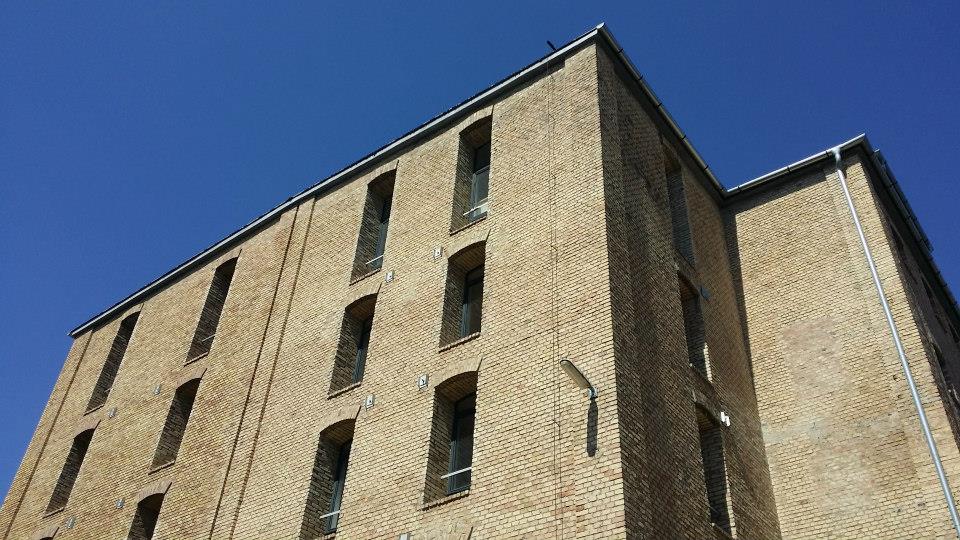
It’s no coincidence that this came up in Budapest rather than another ‘creative’ city hub. I think that in Amsterdam, London, Paris, New York, or even in Berlin these days, this would be very difficult to do as a private initiative, as we are. That tells you something about the opportunities in Budapest right now, and what might be ahead for the city over the next five to ten years.
Can you explain a bit more about how this collaboration with Art Quarter Budapest came about? Were you searching for opportunities in Budapest? What attracted you specifically in this location?
It was quite serendipitous actually. Initially I was scouting for potential venues in Budapest to do an event with 4DSOUND. We had been nomadic with the system for quite a while, traveling between temporary venues and festivals, trying to find new spaces and partners every couple of months to continue our programmes. We enjoyed the process a great deal but it became pretty draining after an extended period.
When I found the space and met Wolfgang in March 2015, I wasn't searching for a permanent facility at all. I accidentally found out about Art Quarter Budapest through an artist friend who suggested me to go and at least have a look. I found a ruined warehouse in the periphery of the faded industrial belt in the south of Buda. The place was in total disrepair. I almost left immediately, but Wolfgang insisted to show me around. He talked passionately about his plans with the estate, developing a sustainable model to support an independent and international artist community to establish itself there, which immediately resonated with the plans that the guys and I had discussed at length before.

Going up a staircase filled with old doors, pieces of floor and furniture covered in chalk and dust, we moved into a 40-meter long abandoned warehouse space with wooden columns and beams in the ceiling above. Rows of open holes in the walls where there used to be windows gave a view out onto the river Danube flowing right next to the estate. Parts of the ceiling and floor where missing. Walking carefully over narrow pathways of wood that bridged the large holes in the floor, I could see through the structure of the building up and down into similar warehouse spaces two, three stories below and above.
On my way home, everything fell into place for me. The architectural skeleton of the building with its vertical columns and horizontal beams seemed ideal for installing the 4DSOUND system. What if we could take a couple of floors out entirely? What if we could extend the system both in height above your head as well below your feet? I’d dreamed of extending the system down as well as up, into the space below the floor, something that is very hard to realize structurally, especially with a mobile system. This space gave us just the opportunity.
The remote, almost rural location, both part-of and out-of the city, gave me the idea of a space that could be cultivated primarily for creation and inspiration. What we had been envisioning the whole time - to hand over the process to the growing community around 4DSOUND - could really become a reality in such a space. Wolfgang's ambition to turn this into an international meeting place for artists, and the residency spaces that were already being developed, were really promising signs that AQB could open up a new direction for the project.
And so you made the decision to establish the Institute, and then in October 2015, it was publicly announced and officially opened. What happened during the time in between? What was the process like developing the space?
It was a fascinating and pretty turbulent process. An opportunity to officially open the space came up through a collaboration with Contemporary Art Festival Budapest taking place in October, which gave us a tight but workable deadline we had to complete the construction by. The work was done in roughly three periods, with several parts of the estate to develop separately: the core sound space, a reception/ atelier functioning as a project space, and fifteen new rooms as part of an extension of artist residency accommodation at AQB. Things definitely came together in the end, but it wasn’t exactly a smooth process!
The first step was finishing the spatial sound studio itself, so that we could start working there from the summer on. We started, rather ambitiously, by planning ten weeks of residencies during the summer to develop our programme Circadian in the new space. In the end the space only turned out to be half-ready, which meant we were able to install the speaker system but nothing more. So we spent the summer working with the artists on the new productions in a dusty construction site, which wasn’t easy and far from comfortable, but actually a unique experience in itself. I am grateful that we were able to fully experience the space in this transitional state. It gives me the feeling I have a more intimate relationship with the space now, and there is more of a story to tell, as we have fully lived in the process.

Among many memorable moments, I remember preparing Noqturnl with John Connell and Florence To during this summer, where in the middle of the night suddenly a bat that had been hiding somewhere in the space attacked John while he was working on the system (something to do with those high frequencies!). Or being woken up in the early morning by birds sitting in the sunlight of the open windows, their songs accompanying the final moments of our overnight audiovisual wanderings.
The construction obviously had to stop to allow us to work over the summer- meaning the remaining building had to be accelerated to the extreme to get everything ready for the planned opening in October. This second period of the build had to come together in only a few weeks time, while there was also artistic work to prepare for the opening events in the space and refined measurements of the sound system in the space where needed. The pressure was almost unbearable, probably the one of the most nerve-wracking and exciting projects we’ve ever undertaken. The speed of transformation of the spaces from day to day was almost unbelievable, and the co-ordination of what needed to be done to make the space ready was miraculous. Everywhere in the building you would walk into men drilling, breaking down walls here and putting walls up there. From the outside it seemed like chaos but everyone knew exactly what they were doing. The building crew was a group of Hungarian-Ukrainians who had worked with Wolfgang on renovating the estate since ten years. Everybody did an incredible job.

So, the building process extended right into the eleventh hour, just before the actual opening event. But we got there! Doing the shows in the freshly completed space was probably the most exhilarating experience I have had with the system. It was really a joy to experience. Afterwards, there was still much to do, so the process continues and by the start of spring 2016 everything is expected to be finally completed. From then we will be able to start fully developing our Artist Residency programme at the Institute.
In the new space, the columns of the 4DSOUND system have disappeared. Were you striving for a different look of the system? What is happening with the other system with the columns?
The original 4DSOUND system with the columns is designed to be a mobile stage, so we will continue to use it for temporary installations and touring. Those columns were a solution we came up with to enable a structure that would hold the speakers in the right place and that could be built up on-site from the ground. But there are several constructions thinkable, dependent on the space and circumstances.
At the Spatial Sound Institute we were able to integrate the system entirely within the original architecture of the space, hence no columns are needed. It was a wonderful coincidence that the wooden columns and beams in the warehouse space at AQB had perfect measures for installing the system, so we could leave the original old wood in the space intact and use it as a frame for the speakers horizontally and vertically. The space consists of three stories of the original warehouse with the floors taken out, so you have about ten meters height. The speakers are installed on four vertical levels, one level of speakers three meter below your feet, one layer of speakers leveled with the grating floor, one level a bit above head and one level on the ceiling.
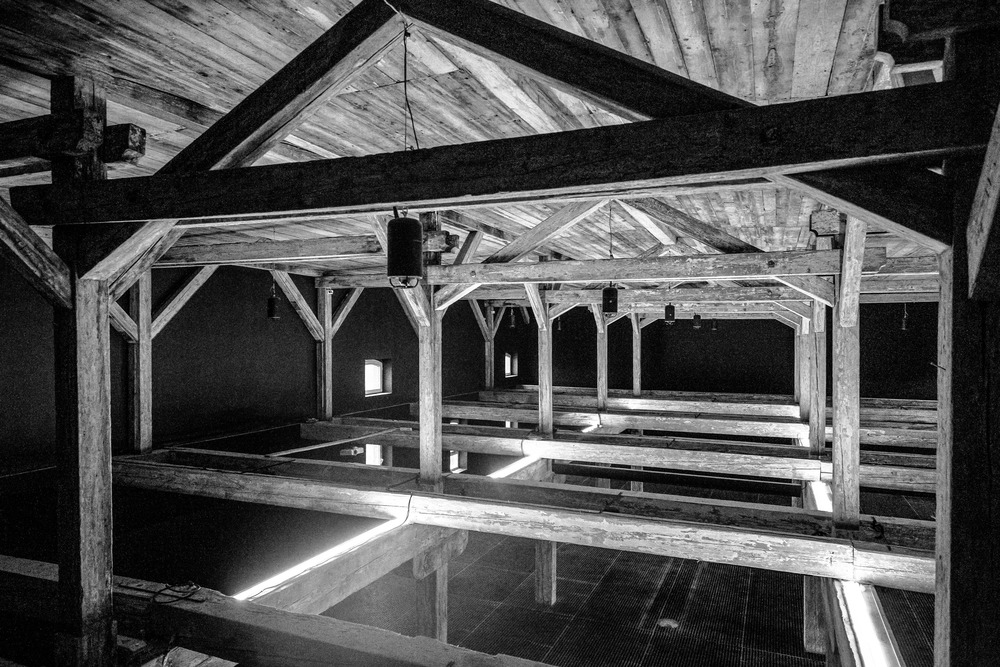
The look and feel of the system in this space is much more lightweight and perhaps more elegant than the original system. The system itself is less present and more invisible, so more attention goes to the space itself. The wooden beams were also a perfect structure to realize a polymer grating floor at three meters above the ground. The depth underneath is something that lifts you off your feet. The first time you step on it, you will probably walk very cautiously for a while, before you feel confident you will not fall down. Its very instinctively disorienting and the perception of sound below you is dramatically improved, even just because of the psychological awareness of depth in this space.
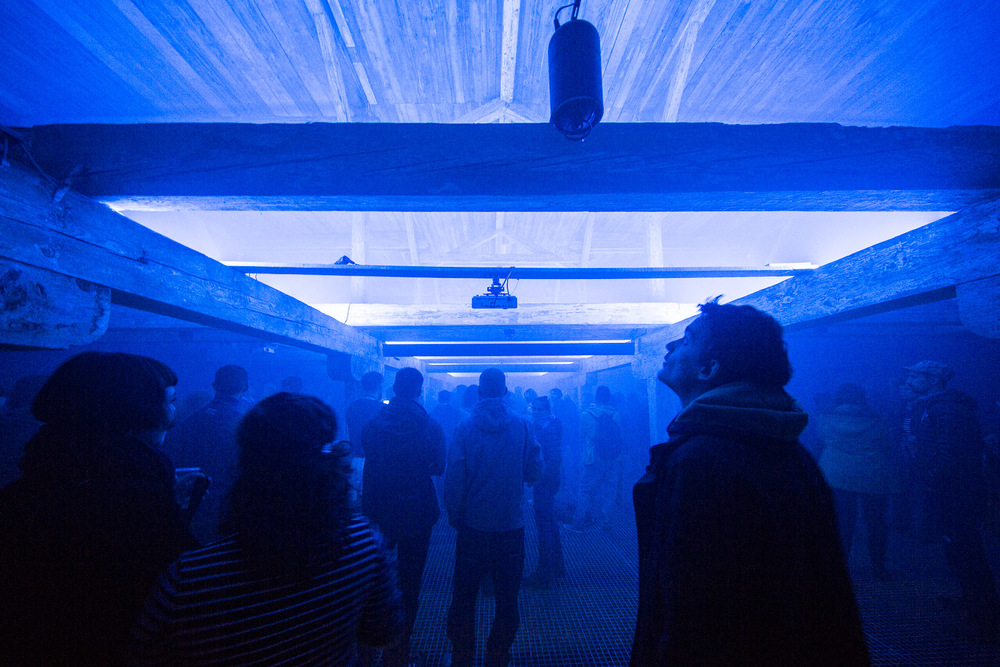
There were some other touches we wanted to give to the space to enhance this feeling of weightlessness and loss of orientation. We chose to paint the floor and walls in the colour 'eigengrau', supposedly the colour you see in darkness with your eyes closed. It’s a very deep dark grey with a slight hint of blue. It seems to be black, but it’s not. The space has an invisible installation of blue and white neon-lights tubes above your head and below your feet, along the entire length of the space, designed by the young Dutch light artist Nikki Hock that we work with regularly. The surrounding colour eigengrau and the single frequency, diffused quality of the neon-lights were intended to make the space feel like a void - both viscerally and associatively. It focusses on the experience of the observer being immersed within this space without interference. The light helps to lose grip of the space, creating a different sense of spatiality. One that triggers sensitivity, awareness and above all heightens the auditory experience.
For the opening of the space you presented a 'Sound Exhibition'. Can you explain where the idea came from?
The opening of the Spatial Sound Institute was also the first time we presented the 4DSOUND system in Hungary. We were aiming for a programme that would not only do justice to opening the new space, but also give an accessible and diverse showcase to an entirely new audience. We decided to bring many of the key works created for 4DSOUND together into one presentation, something we hadn't done before. We also inserted a few live shows and lectures to the programme that would complete the selection and turn the exhibition into a comprehensive overview of some of the major developments in our work from the past four years. You can watch a feature on the Institute that national TV station Hirado did here.

Created for many different contexts and occasions, the different works that came together formed an exhibition of 'sound sculptures'. It was literally a collection of physical creations with sound in space. Normally, when you visit a sculptural exhibition in a museum or gallery, the time aspect is less pre-defined, meaning the audience determines its own timing and narrative throughout the exhibition. Since we are dealing with sound works that unfold explicitly in time, this still felt more composed than an exhibition but also essentially different from a concert.
Freely exploring the space of a music work and discovering new things in it by how you move and behave inside it, is a very vital aspect of the spatial sound experience. It’s also a way of interacting with music that is still quite unexplored territory, and I feel there is a lot of potential to come out of that still.
What were the reactions from the audience? Did they feel they were 'listening to' an exhibition, or were they still part of a long concert?
I think it was probably one of the most attentive and concentrated crowds I have seen in 4DSOUND, which was so nice to witness for us.
We presented the works one after the other, continuously for twelve hours. Most of the audience probably didn’t experience a beginning or end, but instead entered a space they were exploring for a while with their ears. This form of presentation is essentially immersive, you cannot overview it in its entirety. I think this helped the audience to forget about traditional definitions like 'composition', 'installation' or 'performance'. They interacted with the works differently. People could sit or lay inside these creations, walk inside them or around them, listen to them from a distance or immerse fully in them, expose themselves to them over a long period of time or have a short instantaneous interaction.

The live performances that we included as part of the exhibition felt quite distinct from a regular music presentation. During the opening night there were sound performances by Frank Bretschneider and Gabor Lazarintersected with sculptural sound works by Max Cooper, but because of the enveloping haze and diffused light in the room I think most people in the audience had no idea where, or even who, was playing when. This makes you listen differently for sure: you quickly attune to a more direct experience of sounds appearing in the space. Maybe disorienting and even disquieting for some, but this might be necessary to get people out of their regular patterns of behaviour and stimulate a different receptivity.

During Marcel Wierckx's show 'White Light Black Static', the artist was practically invisible and the centre of focus is a large visual square in the middle of the room, that people could sit inside or around. The live improvised aspect was very apparent to me, it does feel like a real-time living performance, but the artist controlling this process is pulling the strings behind the scenes. This is another form of immersing the audience in an experience that transcends the expected, and can therefore trigger responses that are out-of-the-ordinary, leading the listener into unfamiliar territory, opening the door to potential new insights and perceptions.

Personally, I experienced the durational aspect of the exhibition as very impressive, although I was probably one of the few people that witnessed this entire process unfolding. The way the space transformed in atmosphere and energy from midday to midnight, the effect of the changing light during of the day, the different sound works and the way people started 'using’ the space in a different way throughout the course of the exhibition, was remarkable. When the exhibition started the space was filled with bright daylight. People walked around like they would in a gallery, focussing their attention to different corners and sides of the space, driven by invisible dynamics of moving sounds as the space was empty and there was nothing particularly to look at. As the day evolved and light started to fade, people started to move less and became less analytical in their attitude. They started to surrender more to the experience and the average time that people spent in the system became extended.
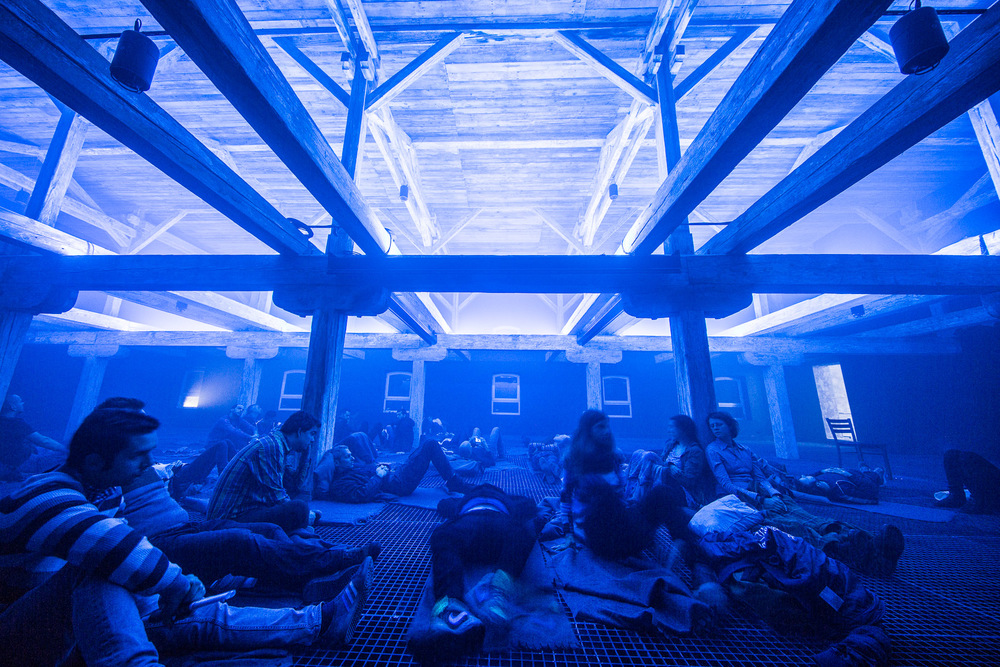
I remember seeing people wake up in surprised confusion and instantly start moving around the space when the hectic noise of Marco Ciciliani's work 'K' interrupted the deep trance that was induced upon them before by the work of Murcof. The exhibition ended both days in almost darkness and thick haze with a deeply meditative and minimalistic performance of Noqturnl by John Connell and Florence To. The people that were still in the space at midnight must have felt completely detached from reality.
Some feedback I got after the opening was that some of the artists seemed to stay quite close to their regular way of performing, and the spatiality could be more integrated into performances. What do you think of that? Do you think it is too much for the performers to deal with on top of all the other aspects of performing live? Wouldn't it be better to work with spatial specialists who accompany the artists?
I see this quite differently- i think it's the opposite actually. The spatiality of sound should become an integrated part of thinking about and creating music, just as integrated as rhythm, melody, harmony... If you see it as a dimension external from the musical creation itself, it doesn't really come to life. Its not easy to just play an existing composition spatially and make it work. Once you start working with sound in that way, you will start to make different choices.
I can understand if some people felt there is much more potential for artists to explore. But what do you expect from someone having had at most a week to practice this? Space is a complex instrument, as complex to master fully as the piano, or violin.. So it might take a lifetime for someone to get the most out of it. This won't just be a development for the next five years, but for the next fifty years, before we fully understand the real potential of what we're just getting started with. But we're seeing big leaps forward in ideas, techniques, control and performance all the time.
Now that the Institute has opened, what are the upcoming plans with the permanent facility?
The most important is that we start creating a place that allows much more opportunity for interaction and discourse on the emerging field of spatial sound. We’re going to do this by hosting ongoing artist residencies, thematic research and educational courses. We will be able to house multiple artists in our own guest apartments in the complex so a lot more artists will be able to work with the medium than we’ve been able to facilitate so far. We are curating workshops, lectures and presentations around specific themes connected to space and sound, bringing some hugely interesting voices in their respective fields together to interact on these topics. We will also start to offer regular courses in spatial sound design and software programming, but also courses in deep listening and meditation through sound.
The motor behind the Spatial Sound Institute is the creative community that want to interact with spatial sound and discover what can be done with it. We have received so many inspiring proposals from forward-thinking artists and researchers over the past years, which gave us the confidence to establish the Institute, and we’re excited to formally open applications for the programme in the Spring.
Do you have an end goal in mind with 4DSOUND and the Institute?
I would be really satisfied if we could encourage a marked change in the quality of our everyday experience. We are committed to what you could call a new ecology of listening, improving the sound within and of our environments and expanding our ability to listen. I think this is a movement that will really begin to take shape over the coming years as we evaluate many aspects of modern life, of our shared environments, and our understanding of sound in influencing this.
—
Photography: Georg Schroll and Fanni Fazakas
Related:
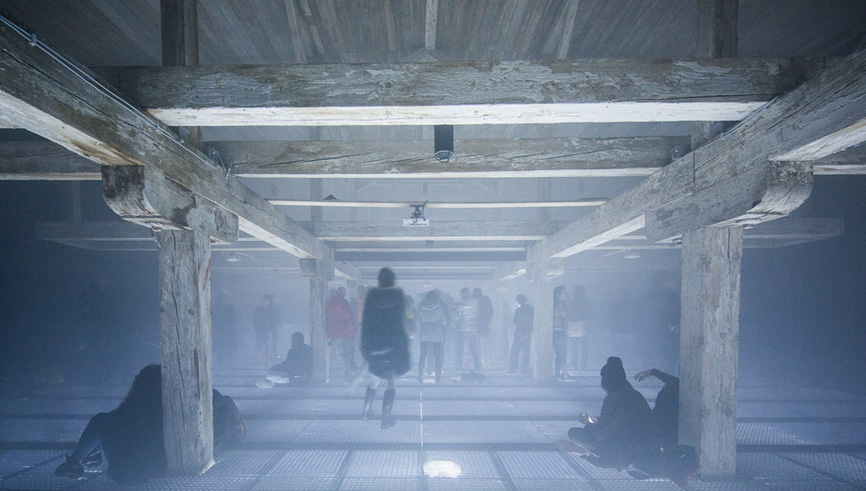 ‘4DSOUND: A Retrospective’ (2015)
‘4DSOUND: A Retrospective’ (2015)  ‘Understanding Space through Sound’ (2015) [PUBLICATIONS]
‘Understanding Space through Sound’ (2015) [PUBLICATIONS]